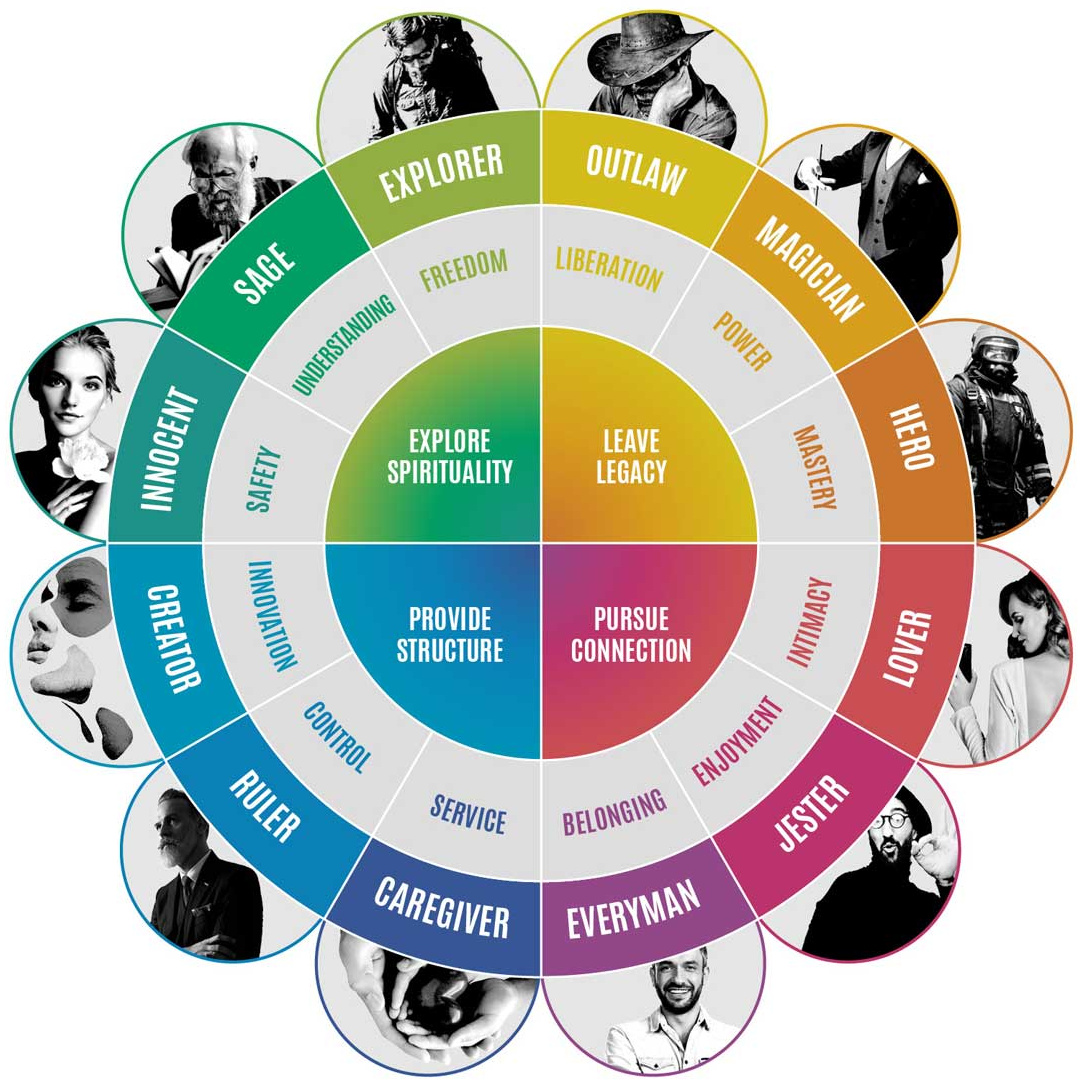Effective branding has become paramount for businesses seeking success in today’s competitive landscape. Brands that can tap into the subconscious desires of their target audience and establish a deep psychological connection have a significant advantage. This is where brand archetypes come into play. Let’s explore the concept of brand archetypes, their significance in branding, and how they can help you connect, relate, and succeed in the dynamic world of marketing.
The Role of Brand Archetypes in Shaping Brand Identity
Brand archetyping refers to the process of assuming human character traits to a brand to accurately reflect that brand’s values and messages. By presenting a brand as an archetypal persona, businesses can make themselves more relatable and recognizable to consumers who share similar values. Brand archetypes play a vital role in shaping brand identity, influencing consumer behavior, and captivating audiences through the art of storytelling. Understanding the psychology behind consumer behavior and leveraging the power of archetypes can help businesses establish a deep connection with their target audience.
How Psychology Influences Consumer Behavior and Brand Perception?
Psychology plays a significant role in influencing consumer behavior, and savvy marketers have long utilized psychological principles to shape consumer perceptions. Successful branding goes beyond mere transactions and taps into the subconscious, creating a deep psychological connection with consumers.
Let’s look into how branding, when rooted in psychological insights, can captivate audiences and establish a lasting impression. By employing storytelling techniques and invoking universal archetypes, brands can evoke emotions and forge a strong bond with their target audience.

The Storytelling Aspect of Branding and Its Impact on Audience Engagement
Storytelling has been a powerful tool for captivating audiences since time immemorial. In the realm of branding, storytelling helps brands communicate their values, mission, and unique selling propositions in a compelling and relatable manner. By utilizing the inherent power of storytelling, brands can engage their audience, build brand loyalty, and ultimately drive business success. These archetypes capture the fundamental desires, fears, and strategies that drive brands, allowing them to connect with their target audience on a deeper level

Know the 12 Brand Archetypes:
Let’s explore the twelve brand archetypes, such as The Innocent, The Explorer, The Sage, The Outlaw, The Magician, The Hero, The Lover, The Jester, The Everyman, The Caregiver, The Ruler, and The Creator, and understand how they contribute to the overall brand identity.
The Creator – Igniting Innovation and Self-Expression
Embodying the desire to create something of lasting value, the Creator archetype fuels brands that champion self-expression, choice, and innovation. Brands like YouTube, Crayola, and Sony encourage individuals to turn their ideas into reality are best examples of the Creator brand archetype. By fostering a culture of imagination and originality, these brands inspire their audience to unlock their creative potential and solve problems through innovative means.
The Hero – Inspiring Courage for a Better World
With unwavering determination and a focus on making the world a better place, the Hero archetype is synonymous with brands that exemplify courage and mastery. Nike, Red Cross, and the Army serve as beacons of inspiration, addressing social problems and motivating people to take action and can be considered as the Hero brand archetype brands. By encouraging bravery and overcoming adversity, these brands empower individuals to become heroes in their own lives and communities.
The Outlaw – Revolutionizing the Status Quo
Unconventional and rebellious, the Outlaw archetype disrupts the norm and seeks to overthrow what isn’t working. MTV, Harley Davidson, and Howard Stern epitomize this cutting-edge approach, blazing new trails with their revolutionary attitudes, which are trademark of the brands under the Outlaw brand archetype. By challenging conventions and embracing their unique values, these brands inspire individuals to break free from conformity and embrace their own revolutionary spirit.
The Lover – Cultivating Intimacy and Connection
At the heart of the Lover archetype lies the deep desire for intimacy, beauty, and connection. Brands like Godiva, Victoria’s Secret, and Hallmark help individuals find love and friendship through their emphasis on beauty, communication, and closeness, which reflect the characteristics of the Lover brand archetype. By creating experiences that evoke emotions and celebrate relationships, these brands nurture connections and bring people closer together.
The Citizen (Everyman) – Fostering Belonging and Reliability
The Citizen archetype represents brands that prioritize empathy, unpretentiousness, and resilience. Brands such as Discover, Wrangler, and Blake Shelton cultivate a down-to-earth culture, creating products and experiences that resonate with everyday life. By fostering a sense of belonging and trust, these brands provide individuals with a reliable anchor in a fast-paced world.
The Sage – Unleashing the Power of Knowledge and Reflection
Guided by a thirst for truth, the Sage archetype embraces intelligence, knowledge, and reflection. Brands that fall under this archetype include The New York Times, Oprah Winfrey, and Harvard University serve as thought leaders, providing expertise and encouraging critical thinking. By seeking information and knowledge, these brands empower individuals to understand the world around them and make informed decisions.
The Explorer – Embracing Authenticity and Curiosity
The Explorer archetype embodies independence, authenticity, and curiosity. Brands belonging to this brand archetype like REI, National Geographic, and Jeep inspire individuals to pursue a more fulfilling and authentic life. By offering products and services that facilitate exploration and freedom, these brands encourage individuals to take the road less traveled and embark on transformative journeys of self-discovery.
The Innocent – Nurturing Idealism and Optimism
The Innocent archetype embodies idealism, optimism, and the pursuit of happiness. Brands associated with morality, goodness, and nostalgia like McDonald’s, Coca-Cola, and Volkswagen belong to the Innocent brand archetype. By promoting love, peace, and happiness, these brands strive to create a sense of joy and optimism in the lives of their audience, reminding them to embrace the goodness in the world.
The Ruler – Establishing Control and Stability
With confidence and responsibility at its core, the Ruler archetype seeks to create prosperity and success. Brands that embody the desire for control and promote stability like Verizon, Microsoft, and Rolls Royce constitute the Ruler brand archetype. By offering products and services that help individuals organize and exert influence, these brands become pillars of reliability and empower their audience to take charge.
The Jester – Spreading Laughter and Fun
Playful, spontaneous, and humorous, the Jester archetype aims to bring laughter, fun, and joy into the world. Brands that embrace a light-hearted and freewheeling culture like Old Spice, Geico, and M&M’s can be seen as those brands with the Jester brand archetype. By embracing curiosity and playfulness, these brands create experiences that allow individuals to enjoy life to the fullest and infuse moments with humor and delight.
The Caregiver – Nurturing Compassion and Dedication
The Caregiver archetype embodies compassion, nurturing, and dedication. Brands such as Salvation Army, Campbell’s, and Mother Teresa that exemplify these traits, going the extra mile to help others can be considered as brands belonging to the Caregiver brand archetype. By serving families and providing excellent customer service, these brands create a sense of care, protection, and stability, fostering a nurturing environment for their audience.
The Magician – Inspiring Transformation and Insight
The Magician archetype taps into intuition, insight, and inspiration to make dreams come true. Brands like Disney, TED, and MAC Cosmetics possess transformative qualities, often incorporating spiritual or psychological elements. By expanding collective consciousness and providing unique visions, these brands empower individuals to embrace their dreams and live a more magical life.
The Big Picture
Brand archetypes offer a fascinating glimpse into the essence of successful brands and how they connect with their target audience. Each archetype brings forth a unique set of desires, fears, and strategies, which, when harnessed effectively, can create powerful brand. Choosing the right archetype and maintaining consistent messaging can help foster a sense of belonging, exclusivity, and connection. So, take the plunge into the branding rabbit hole armed with the knowledge of the 12 brand archetypes, and unlock the potential to connect, relate, and succeed in the ever-evolving marketplace.



